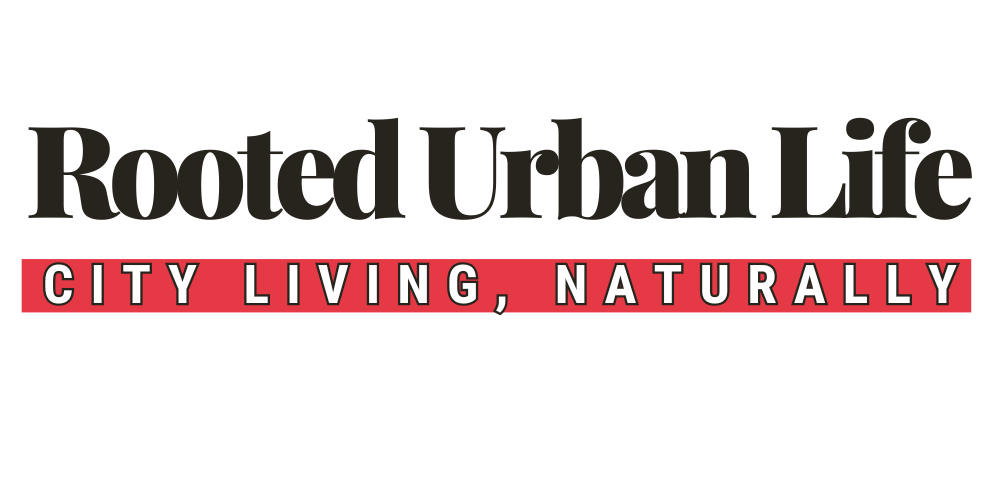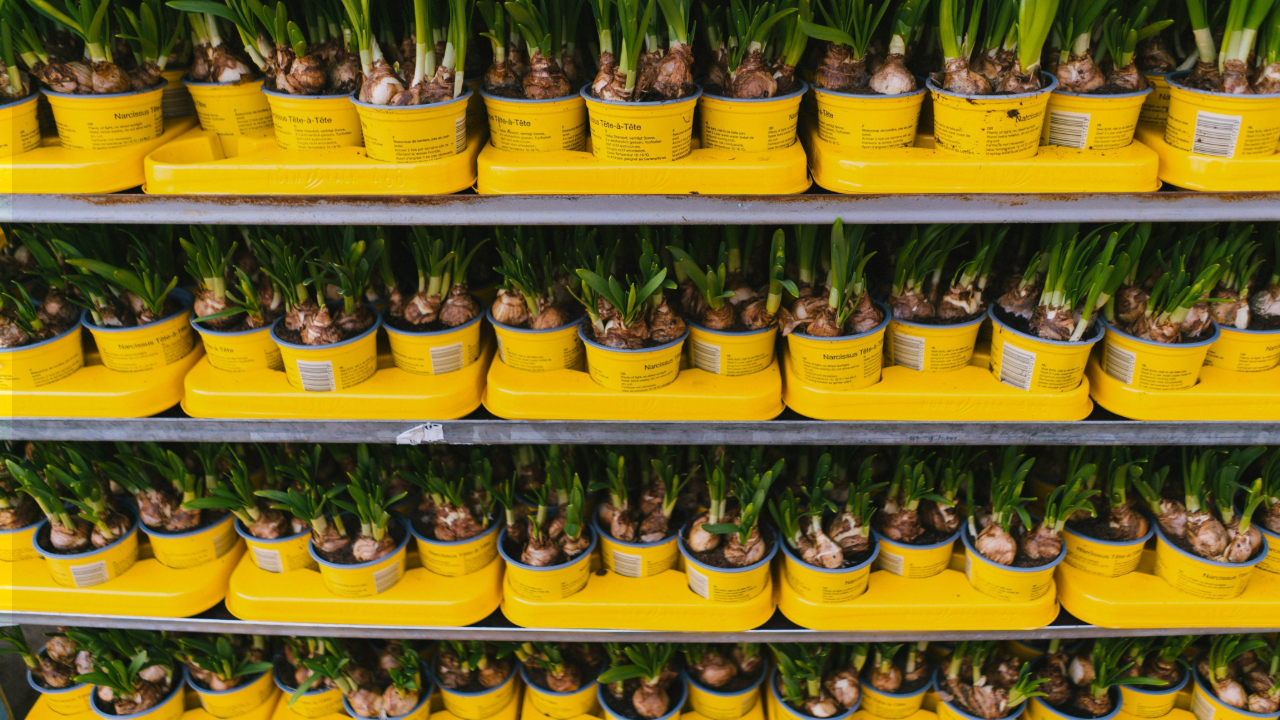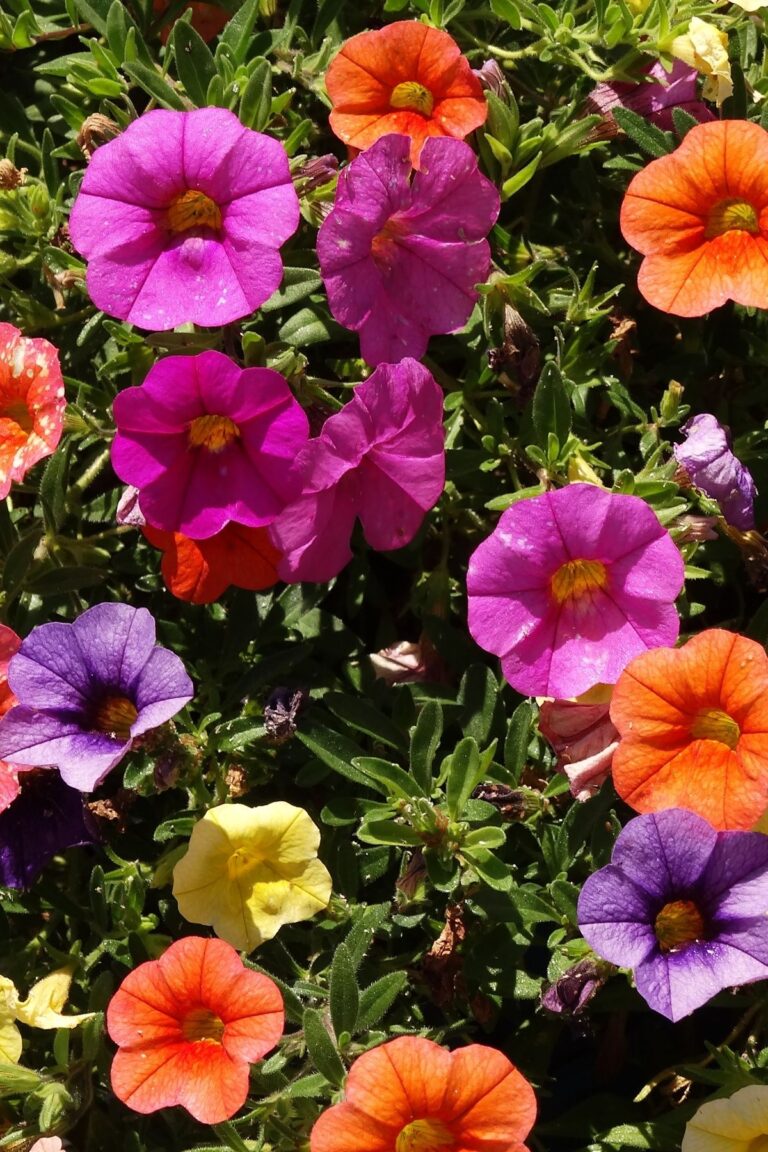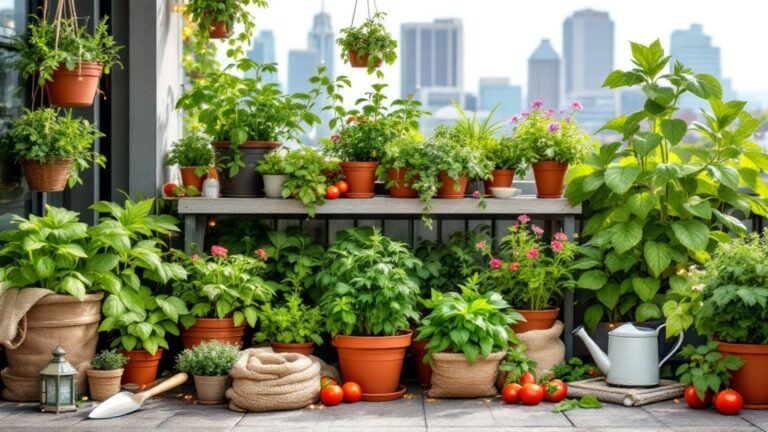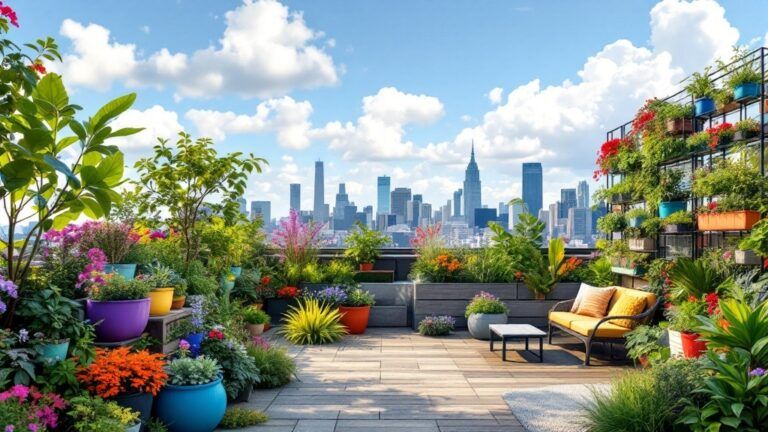Essential Guide to Fall Bulb Planting
Are you staring at your emptied gardening containers or raised beds, wondering how to turn them into a beautiful garden ready for next season? Planting bulbs can be the answer. By following the suggestions in our detailed guide, you can turn your balcony into a symphony of colors in just a few short months.
Why do we plant bulbs in fall?
The easy answer is that bulbs need different environmental conditions to develop than seeds do. This is because:
- The soil stays warm longer, even when the temperatures start dropping. This allows the bulb enough time to develop strong roots so that they can survive the winter.
- Bulbs need to “sleep” or be dormant for a period of time in order to trigger blooming.
- As the weather cools down, there will be fewer weeds to compete with for resources.
Choosing the right bulbs
When you decide what to plant, there are different factors to consider:
- Your gardening zone: You want to select plants that grow well in your area. To find out your hardiness zone, you can check sites like: http://planthardiness.gc.ca/ or https://planthardiness.ars.usda.gov/.
- Light requirements: Observe your space and determine how many hours of sun it receives per day and choose the bulbs accordingly.
- Soil type and drainage: Bulbs like a soil that drains well to prevent rotting. You may need to test your soil and amend it if necessary.
- Quality of the bulbs: Choose the biggest bulbs you can find. They have to be firm, plump, without spots, mold, or damage.
- Bloom time: Think about creating a harmonious mix of early, mid, and late-season blooming bulbs.
- Container suitability: Make sure that the container is suited for the type of bulbs you want to plant. It has to be big enough to accommodate the roots and the size of the fully grown plant.
- Disease resistance: Choose bulb varieties that are more resistant to pests and disease.
- Maintenance: Low-maintenance bulbs are a better choice for beginners or gardeners with busy schedules. Research the care requirements before making your final choice.
- Aesthetics: Choose plants with colors, shapes, and sizes that suit your preferences and the look you want to have in your garden.
- Edibility: Include edible bulbs in your garden planning.
Once you have made your final decision, plant them using the “lasagna planting method.” Layer different varieties in the same area based on the flowering time to ensure succession blooming throughout the seasons.
Here are some suggestions of bulbs that do well in containers, require minimal care and are suited for beginners:
Flowering Bulbs for Containers (Beginner-Friendly)
| Plant Name | Criteria | Care & Planting Tips |
|---|---|---|
| Crocus | Affordable, easy to find, minimal care | Plant 3 inches deep, 2 inches apart. Prefers full sun to partial shade. |
| Grape Hyacinth | Affordable, widely available, easy to grow | Plant 3-4 inches deep, 2 inches apart. Prefers full sun to partial shade. |
| Snowdrop | Affordable, early bloomer, easy to find | Plant 2-3 inches deep, 3 inches apart. Prefers partial shade and well-drained soil. |
| Anemone | Inexpensive, easy to find, low maintenance | Soak tubers overnight, plant 1-2 inches deep, 6 inches apart. Requires full sun. |
| Allium | Moderately priced, widely available, unique shape | Plant 4-6 inches deep, 6-8 inches apart. Requires full sun and well-drained soil. |
| Dutch Iris | Affordable, easy to find, versatile | Plant 4 inches deep, 4-5 inches apart. Prefers full sun and well-drained soil. |
| Freesia | Moderately priced, easy to find, fragrant blooms | Plant 2 inches deep, 3 inches apart. Prefers full sun to partial shade. |
| Hyacinth | Moderately priced, widely available, fragrant blooms | Plant 4 inches deep, 3-4 inches apart. Requires full sun to partial shade. |
| Ranunculus | Inexpensive, easy to find, abundant blooms | Soak tubers, plant 2 inches deep, 4-6 inches apart. Prefers full sun. |
| Scilla | Affordable, easy to find, low maintenance | Plant 3 inches deep, 3-4 inches apart. Prefers partial shade and well-drained soil. |
If you want to try edible bulbs, here are some suggestions, along with companions that you may want to consider.
Edible Bulbs for Containers
| Plant Name | Criteria | Care & Planting Tips | Companion Plants |
|---|---|---|---|
| Garlic | Affordable, widely available, easy to grow | Plant individual cloves 2 inches deep, 4-6 inches apart. Requires full sun and well-drained soil. | Parsley, Thyme, Chamomile (enhances flavor) |
| Onion | Inexpensive, easily available, minimal care | Plant sets 1-2 inches deep, 4-6 inches apart. Needs full sun and well-drained soil. | Carrots, Beets, Lettuce |
| Shallots | Moderately priced, easy to find, beginner-friendly | Plant 1-2 inches deep, 6-8 inches apart. Needs full sun and well-drained soil. | Strawberries, Lettuce |
| Leeks | Affordable, easy to source, long growing season | Plant seeds or transplants 1 inch deep, 6-8 inches apart. Requires full sun and well-drained soil. | Carrots, Celery, Onion |
| Chives | Inexpensive, widely available, low maintenance | Plant seeds or divisions 1/4 inch deep. Prefers full sun to partial shade and well-drained soil. | Carrots, Grapes, Tomatoes (deters pests) |
| Elephant Garlic | Moderately priced, easy to find, unique large cloves | Plant cloves 4-6 inches deep, 10-12 inches apart. Requires full sun and well-drained soil. | Tomatoes, Beets, Cabbage |
| Saffron Crocus | Pricier, but unique and rewarding for saffron production | Plant corms 3-4 inches deep, 3 inches apart. Requires full sun and well-drained soil. | Marigolds, Sage (deters pests) |
| Multiplier Onions | Affordable, easy to source, yields multiple bulbs per plant | Plant 1 inch deep, 6-8 inches apart. Prefers full sun and well-drained soil. | Carrots, Beets, Lettuce |
| Turmeric | Moderately priced, harder to find, but unique and versatile | Plant rhizomes 2 inches deep in well-drained soil. Needs partial shade and warmth. | Beans, Cilantro, Lemongrass |
| Ginger | Moderately priced, harder to find, excellent for containers | Plant rhizomes 2 inches deep. Requires partial shade and well-drained soil. | Peppers, Cilantro, Lemon |
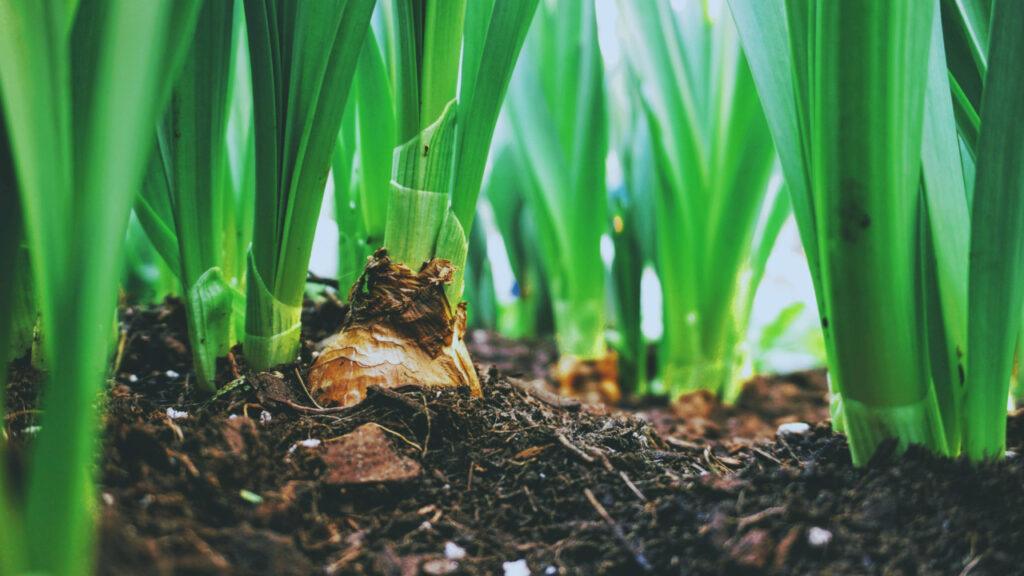
Preparing the garden
Now that you have selected your bulbs, you have to start preparing the garden.
- Choose a planting spot that receives a minimum of 6 hours of sun a day.
- Loosen the soil about 12 inches deep and add compost. If you plant in containers, use a good quality potting mix with good drainage. You can add perlite or sand if you have clay soil. Good drainage is very important because too much water can cause the bulbs to rot.
- Plant the bulbs as specified on the packet. A rule of thumb is to plant the bulbs at a depth of about 3 times their size. Space them according to the size of the mature plant.
Uncommon Bulbs and Tubers
If you are ready to go off the beaten path and try less common varieties of bulbs these are some suggestions.
| Plant Name | Criteria for Ranking | Care & Planting Tips |
|---|---|---|
| Dahlia | Moderate maintenance, widely available, abundant blooms | Plant tubers 6-8 inches deep, 12 inches apart. Requires full sun and regular watering. Deadhead spent flowers. |
| Liatris | Low maintenance, moderately available, unique spiky flowers | Plant corms 1-2 inches deep, 6-8 inches apart. Prefers full sun and well-drained soil. Drought-tolerant. |
| Canna | Moderate maintenance, widely available, tropical appearance | Plant rhizomes 4-6 inches deep, 12-18 inches apart. Requires full sun and moist soil. Lift rhizomes in cold regions. |
| Tuberose | Moderate maintenance, moderately available, fragrant flowers | Plant bulbs 2 inches deep, 6-8 inches apart. Requires full sun and well-drained soil. Keep soil evenly moist. |
| Eucomis (Pineapple Lily) | Low maintenance, less available, exotic appearance | Plant bulbs 3-4 inches deep, 6 inches apart. Prefers full sun to partial shade and well-drained soil. |
| Agapanthus | Low maintenance, less available, showy blooms | Plant bulbs 2 inches deep, 8-10 inches apart. Prefers full sun and well-drained soil. Water regularly during blooming. |
Caring for the Bulbs
Bulbs are fairly easy to care for if you keep in mind a few important elements:
- Do not overwater as the bulbs may rot in excessive humidity. Check the soil regularly and only water when needed. Soil in containers tends to dry faster, so make sure to check often.
- Check the temperature regularly. If it is too hot, move containers to a cooler location such as a garage. If you planted the bulbs in raised beds, then you can provide temporary shade by using garden fabric, shade cloth, or mulch.
- Do not overfertilize. This would cause the bulbs to grow and potentially flower ahead of time. Use a balanced, water-soluble fertilizer in the bottom of the hole at planting time. Fertilize again when the leaves start to grow in spring.
Protecting Your Bulbs from Pests and Disease
Many times I carefully planted my bulbs only to see them dug out the next day by an army of squirrels. Maybe there aren’t that many squirrels in your area, but there are other rodents that would be happy to feast on your bulbs too.
- Consider using wire mesh or garden fabric to cover the bulbs.
- Sprinkling cayenne pepper or garlic powder around can also help, but remember to sprinkle often, especially after it rains.
- Avoid overcrowding the bulbs
- Water at the base and not on the leaves. Too much humidity can favor fungal disease.
- Move containers to warmer areas if it gets too cold and make sure there is good ventilation.
- Check the bulbs regularly for signs of distress or disease.
Tip: Place crushed eggshells around the bulbs to deter snails and slugs.
Avoiding Common Mistakes
- Avoid overwatering as the bulbs may rot. The soil should be moist, but not soggy and containers should have proper drainage.
- Plant bulbs at the correct depth. If they are planted too shallow or too deep, they will not develop properly.
- Choose good quality bulbs, the bigger and plumper, the better. Source your bulbs from nurseries or reputable online sellers.
- Make sure the planting area gets enough sun and follow the planting timeline of your region.
- Allow plants to die down naturally so that they store enough energy to flower again the next season. Note that not all bulbs will flower a second time. For example, forced bulbs (those grown in pots outside of their normal growth season) may not flower a second time. Some bulbs are annuals, so they will only bloom once.
Regional Planting Tips
Here are some tips to consider based on your region:
- Northeast: Plant hardy varieties from September to early November. Use mulch to protect them from the cold.
- Midwest: Plant from mid-September to mid-October. Ensure proper soil drainage by amending if necessary.
- South: Plant from late October to early December. Select heat-tolerant varieties.
- West Coast: Plant between late October and early November. Ensure excellent drainage.
- Southwest: Plant in late fall. Choose drought-tolerant bulbs.
Frequently Asked Questions
Q: How late can I plant bulbs in the fall?
A: You can plant bulbs until the ground freezes. Check the date for the first hard frost in your region and make sure to plant them at least 6 weeks before.
Q: Can I plant bulbs in containers?
A: Bulbs can be planted in containers as long as there is good drainage. If the containers do not have holes, drill them if possible. Use good soil with excellent drainage. Make sure the pot is at least 12 inches deep.
Q: What should I do if my bulbs don’t bloom?
A: This can be due to insufficient light, overwatering, or wrong planting depth. Move the container to an area that receives more sun. Allow the leaves to die back naturally. The age of the bulbs can be a factor as well. Bulbs should be replaced every few years. Overcrowding can also cause some bulbs to not flower. In this case, thin the plants to allow for sufficient space and airflow between the bulbs.
Q: How do I protect my bulbs from pests?
A: Bulbs can be covered with mesh or garden cloth. Sprinkling cayenne pepper or garlic powder around the plants can help.
Q: Should I fertilize my bulbs?
A: A well-balanced fertilizer should be placed on the bottom of the planting hole before planting; more fertilizer can be added when the leaves start growing in spring.
Q: When should I dig up my bulbs?
A: Bulbs can remain in the ground for a few years. If they do not flower as well or are overcrowded, you can dig them out after the leaves die back naturally. Dry them and store them in a paper bag in a well-ventilated area until it is time to plant again.
Weather you select low-maintenance varieties or more exotic ones, the key to a successful spring season lies in understanding your space, selecting good quality bulbs and giving them proper care. Joins our newsletter for more tips and homesteading insights. As your garden starts to grow, share the results of your experiments on social media with the tag #RootedUrbanGardens. We’d love to see your results.
Time for a quiz:
Do you know the difference between bulb, rhizome, tuber and corm? Here it is:
| Storage Organ | Structure Description | Growth Characteristics | Examples |
|---|---|---|---|
| Corm | Solid, swollen underground stem without layers. It gets replaced every year by another corm that grows on top | New shoots grow from the top, roots from the bottom; replaced annually | Gladiolus, Crocus, Liatris |
| Bulb | Layers of modified leaves around a central stem | Grows from a central stem surrounded by layers (modified leaves) | Tulips, Daffodils, Onions |
| Rhizome | Horizontal, underground stem that grows just below the soil surface | Grows horizontally, producing roots and shoots along its length | Ginger, Iris, Canna |
| Tuber | Thickened, underground stem with multiple “eyes” or buds | Buds (“eyes”) sprout shoots and roots; no specific top or bottom | Potatoes, Dahlias, Begonias |
Summary
| Section | Key Points | Details | Thought-Provoking Questions/Insights |
|---|---|---|---|
| Introduction | Overview of fall bulb planting | Importance of planting bulbs in fall due to their growth cycle; preparation for spring flowering. | |
| Why Plant Bulbs in the Fall? | Reasons for fall planting | Establish strong roots, trigger flowering through cold dormancy, and reduce competition with weeds. | |
| Choosing the Right Bulbs | Factors to consider | Climate, flowering time, and personal preferences; examples include tulips, daffodils, crocuses, hyacinths, alliums, and irises. | |
| Preparing Your Garden | Garden bed and container preparation | Ensure proper sunlight, soil depth, drainage, and spacing; use of compost and mulch for healthy growth. | |
| Caring for Your Bulbs | Maintenance and care tips | Avoid overwatering, provide adequate sunlight, use appropriate fertilizers, and allow foliage to die back naturally after blooming. | |
| Protecting Your Bulbs | Pest and disease prevention | Use wire mesh, sprinkle cayenne pepper, ensure proper drainage, and add mulch for insulation. | |
| Common Mistakes to Avoid | Pitfalls in bulb planting | Overwatering, incorrect planting depth, poor-quality bulbs, neglecting sunlight needs, not following seasonal guidelines, and early removal of foliage. | |
| Regional Planting Guides | Regional planting strategies | Specific guidelines for the Northeast, Midwest, South, West Coast, and Southwest to optimize bulb growth and flowering. | |
| Edible Bulbs | Overview of edible bulbs | Garlic, onions, shallots, and leeks as examples; dual-purpose plants that are both decorative and edible. | How does the inclusion of edible bulbs in decorative gardening spaces align with the growing trend of sustainable, self-sufficient living? |
| Uncommon Bulbs and Tubers | Less common choices for extended blooming | Agapanthus, dahlias, liatris, canna lilies, eucomis, and tuberose; tips for growing and maintaining these summer bloomers. | Can we rethink the traditional gardening calendar by integrating less common bulbs and tubers to maintain garden beauty year-round? |
| Layer Your Plantings | Strategy for continuous garden color | Plant early, mid, and late-season varieties together to maintain garden vibrancy from spring to fall. | How might the practice of staggered planting influence biodiversity and ecosystem health in home gardens? |
| General Reflection | What are the potential benefits and challenges of planting bulbs in non-traditional or challenging climates? |

